General
What Is the Motion Graphic Designer Salary? Understanding Earnings in the Industry
Overview
The salary of motion graphic designers exhibits significant variability, influenced by factors such as experience, geographic location, and industry sector. Entry-level positions typically commence at around $50,000, while seasoned professionals can earn upwards of $120,000 annually. This disparity is particularly pronounced in high-demand urban areas like San Francisco and New York, where competitive market conditions drive salaries higher. Furthermore, designers in the advertising and film sectors often command greater compensation compared to their counterparts in corporate settings. Understanding these dynamics is crucial for navigating career opportunities in motion graphic design.
Introduction
In a world increasingly dominated by visual storytelling, motion graphics design emerges as a powerful fusion of creativity and technology, infusing life into static images and captivating audiences across diverse platforms. As this dynamic field evolves, professionals harness advanced software tools to craft compelling narratives that resonate deeply with viewers.
The demand for skilled motion graphic designers is on the rise, particularly as brands acknowledge the undeniable impact of engaging visual content in their marketing strategies. With the integration of augmented reality and the emergence of hybrid animation techniques, the motion graphics landscape is teeming with opportunity and innovation.
Understanding the myriad factors influencing salaries in this competitive arena—from geographic location to industry sector—empowers aspiring designers to navigate their career paths effectively and maximize their earning potential. As the industry braces for a promising future, staying informed about trends and honing essential skills will be paramount for success in this exhilarating field.
Defining Motion Graphics Design: An Overview
Motion graphics design stands as a dynamic and evolving field, seamlessly integrating design principles with animation techniques to produce captivating visual content. This discipline is indispensable across various media platforms, including film, television, advertising, and digital environments. Designers leverage advanced software tools such as Adobe After Effects and Cinema 4D—ideal for 3D modeling, animation, and rendering—to transform static images into dynamic narratives, enhancing storytelling through movement and visual effects.
The significance of animated visuals in media is paramount. As viewers increasingly gravitate towards engaging visual material, the demand for skilled animation designers continues to rise. Indeed, the animation sector has witnessed considerable growth, with forecasts indicating a robust increase in the coming years.
This expansion is driven by the growing integration of animated visuals in advertising, where brands utilize these methods to create memorable and impactful campaigns.
Recent case studies highlight the effectiveness of animated visuals in advertising. For instance, innovative projects that blend 2D and 3D animation have emerged, allowing creators to explore hybrid methods that merge traditional hand-drawn styles with ultra-realistic 3D visuals. This approach not only captures viewer attention but also enriches various design formats, making it a potent tool for brand storytelling.
The accessibility of 3D design has broadened beyond large studios, offering designers novel creative opportunities and techniques that captivate audiences across web design, typography, and app animation.
As the boundaries between design in movement, visual effects (VFX), and cinema continue to blur, new trends are reshaping the animated visuals landscape in 2025. Augmented reality (AR) is emerging as a central theme, exemplified by initiatives such as the Method Man Teenage Mutant Ninja Turtle-themed game for Fortnite, which demonstrate how animated visuals can create immersive experiences.
Expert opinions emphasize the necessity of mastering the fundamentals of design and animation, as these skills are crucial for success in this competitive field. As Ben Barnhart, Content Lead, asserts, “Start with learning the fundamentals of design and animation.” The principles of effective visual design—such as simplicity, consistency, timing, visual hierarchy, storytelling, and iterative feedback—remain vital for crafting compelling content that resonates with audiences.
In summary, animated visuals design is not merely a critical element of modern media creation; it is also a vibrant domain that offers limitless creative possibilities for creators. As the industry evolves, staying informed about the latest trends and techniques will be essential for those aspiring to excel in this exciting arena.

Factors Influencing Motion Graphic Designer Salaries
The motion graphic designer salary is influenced by several critical factors, with experience standing out as the most significant. Entry-level creatives typically begin with a lower salary, while those with extensive experience can command much higher earnings. For instance, the 90th percentile yearly salary for visual artists, which includes motion graphic designers, reaches $100,450. This statistic underscores the potential for lucrative income as professionals advance in their careers.
Geographic location is another pivotal factor affecting income. Designers situated in major metropolitan areas generally enjoy a higher salary due to increased demand and a higher cost of living. For example, the motion graphic designer salary in San Francisco may significantly exceed that of a designer in a smaller city, reflecting the competitive nature of urban markets.
The industry sector also plays a crucial role in shaping salary variations for motion graphic designers. Those employed in advertising or film often receive higher compensation compared to their counterparts in corporate settings, where budgets may be more limited. This trend highlights the importance of aligning one’s career trajectory with sectors that prioritize and invest in creative talent.
Moreover, a creator’s skill set and the quality of their portfolio can greatly impact the salary they can achieve. A robust portfolio that showcases a variety of complex projects can attract opportunities offering a higher salary. For instance, Chris Jung, a notable visual artist, revitalized MTV’s logo sting with his innovative approach, demonstrating how impactful work can enhance a creator’s reputation and earning potential.
As Chris aptly puts it, “Making things move,” encapsulating the essence of what animators aspire to accomplish.
Looking ahead to 2025, factors such as the increasing demand for digital content and the rise of automated design tools will continue to shape the motion graphic designer salary landscape. While automation may reduce the need for certain freelance creators, the demand for skilled professionals—particularly in roles like motion graphic designer—remains strong, ensuring a robust salary for those capable of producing engaging and dynamic content. As companies enhance their digital presence, the role of animators becomes ever more critical, reflecting a rising salary as their skills stay relevant in a shifting market.
Notably, successful branding initiatives, such as the brand identity enhancement for Castania and the digital campaign for Motorola, illustrate how effective design efforts can influence compensation expectations and career trajectories within the industry.
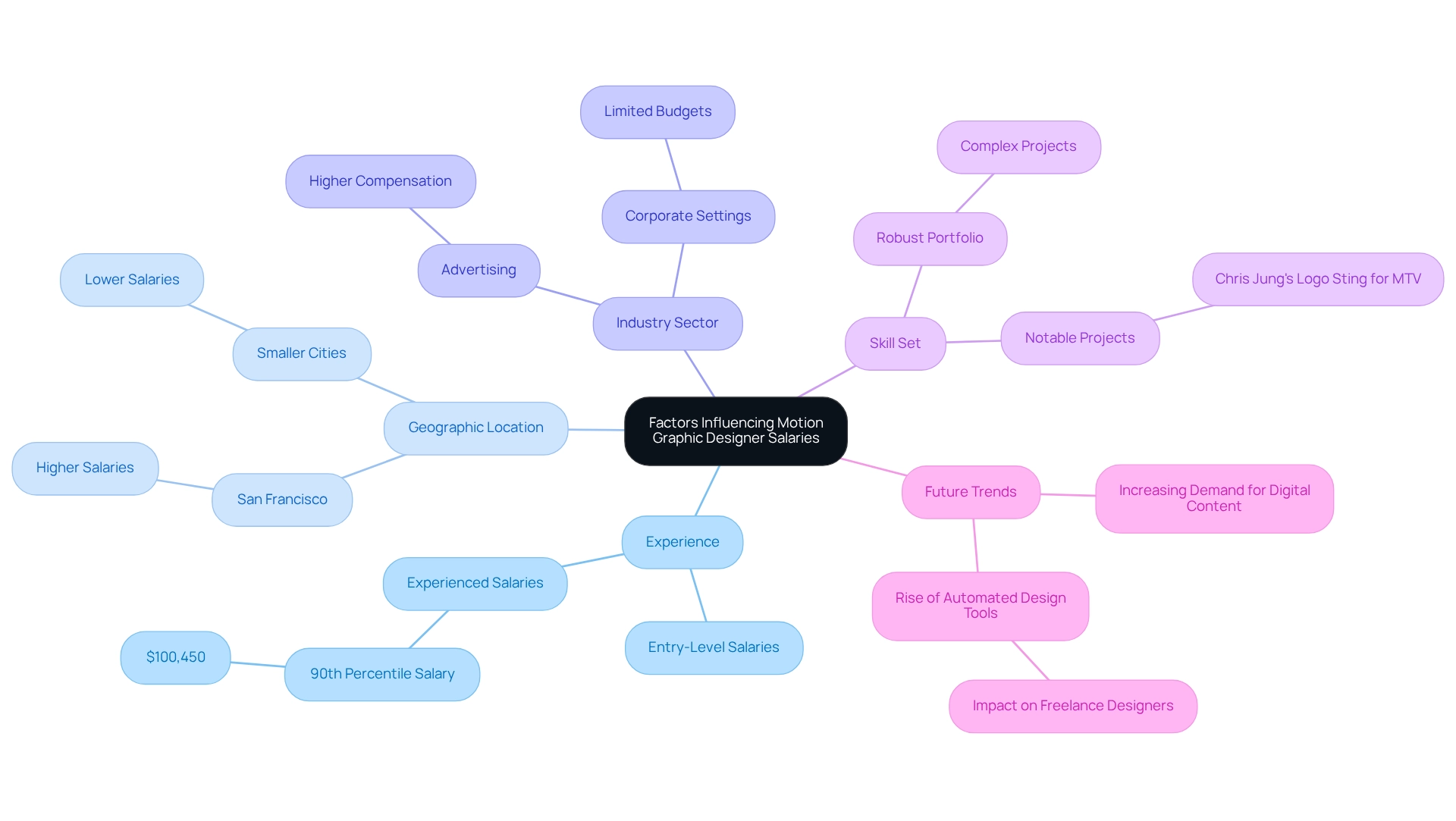
Average Salary of Motion Graphic Designers: Key Figures
In 2025, the typical earnings for a visual effects creator in the United States are approximately $86,167 annually. This figure reflects a spectrum of earnings influenced by factors such as experience and geographic location. Entry-level roles generally commence at around $50,000, while seasoned professionals can command compensation exceeding $120,000 each year.
Notably, in major urban centers like New York and San Francisco, wages are significantly higher, driven by a competitive environment and a strong demand for skilled creatives.
Freelance animators experience a wide range of income, largely dependent on project scope and client budgets. Hourly rates for freelancers can vary from $25 to over $100, showcasing the potential for lucrative opportunities within this sector.
Current trends indicate a robust job market for animated visuals specialists, with approximately 6,700 vacancies for special effects creators and animators expected annually over the next decade. This demand highlights the necessity of staying abreast of the latest software and technological advancements to maintain competitiveness. Graphic designers must continually acquire knowledge and adapt to new tools and technologies to thrive in this evolving field.
Case studies from major cities reveal that the salary of motion graphic designers can vary significantly. For instance, in high-cost urban areas like San Francisco, the average motion graphic designer salary may exceed $100,000, whereas in smaller markets, it might hover around $70,000. This disparity underscores the importance of location in compensation negotiations and career planning.
Moreover, comparable professions, such as art directors and visual creators, also reflect these trends, providing a broader context for understanding compensation dynamics in the creative sector. WonderEight’s successful campaigns for brands like Miranda and Quaker Oats illustrate the impact of effective branding on earning potential in the industry. By delivering compelling content and brand experiences, the agency emphasizes the critical role of talented visual artists in achieving measurable results for clients.
Overall, the income range for visual artists spans from entry-level roles at approximately $50,000 to advanced positions that can exceed $120,000, indicating the diverse opportunities present within this dynamic sector.
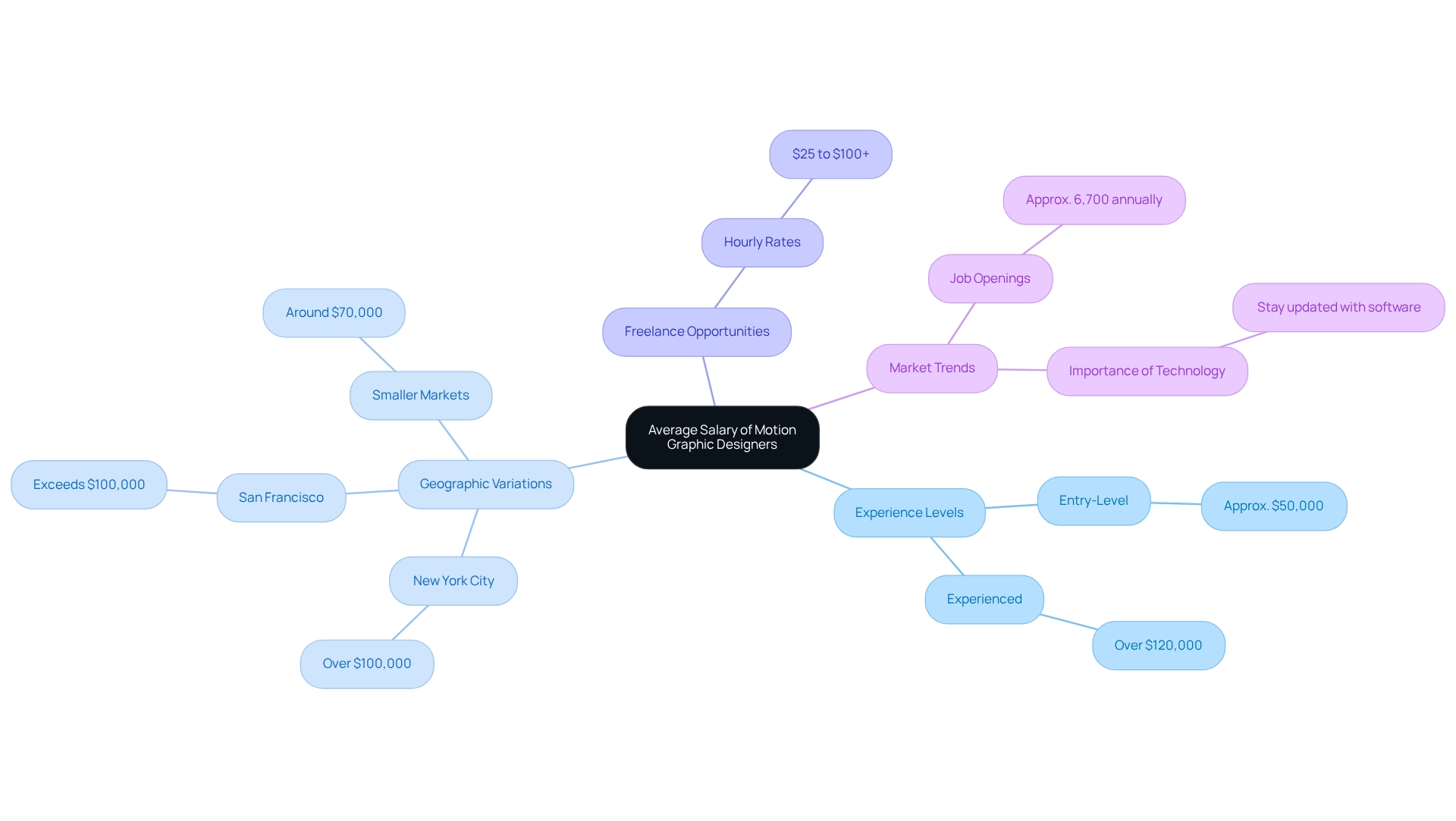
Geographic Salary Variations: Where Do Motion Graphic Designers Earn the Most?
Geographic position significantly influences the earnings of visual artists specializing in animation. In 2025, creators in major urban centers can anticipate considerably higher earnings compared to their peers in smaller markets. For instance, the motion graphic designer salary in New York City is approximately $95,000 annually, while in Los Angeles, it hovers around $90,000.
In stark contrast, those located in rural areas or less populated regions may see their compensation decrease to about $60,000. This disparity in income is closely tied to the cost of living in these areas. Urban locales, while offering greater earnings, also come with increased living expenses, impacting overall financial health. Furthermore, regions with a robust entertainment sector presence, such as California, generally provide more lucrative opportunities for visual artists, underscoring the demand for creative skills in these vibrant markets.
Expert opinions indicate that the pressure to deliver results swiftly in design can sometimes conflict with the creative process. This highlights the necessity for realistic timelines and a supportive work environment to attract top talent. Companies that foster a positive culture may find themselves more appealing to skilled creatives, which in turn influences compensation expectations.
Beyond geographic factors, the educational background of graphic artists also plays a pivotal role in compensation variations. Notably, around 12.2% of Motion Graphic Designer I positions require a master’s degree, which can lead to a higher salary. Industry professionals emphasize that this field offers ample opportunities for creativity and growth, making it an attractive option for those with technical expertise. Case studies, such as Chris Jung’s revitalization of MTV’s logo sting, illustrate the impact of location and industry demand on compensation outcomes.
His work not only enhanced viewer experience but also underscores the importance of skilled animators in high-profile markets. As the sector continues to evolve, understanding these geographic compensation differences will be crucial for brand managers and creatives alike.
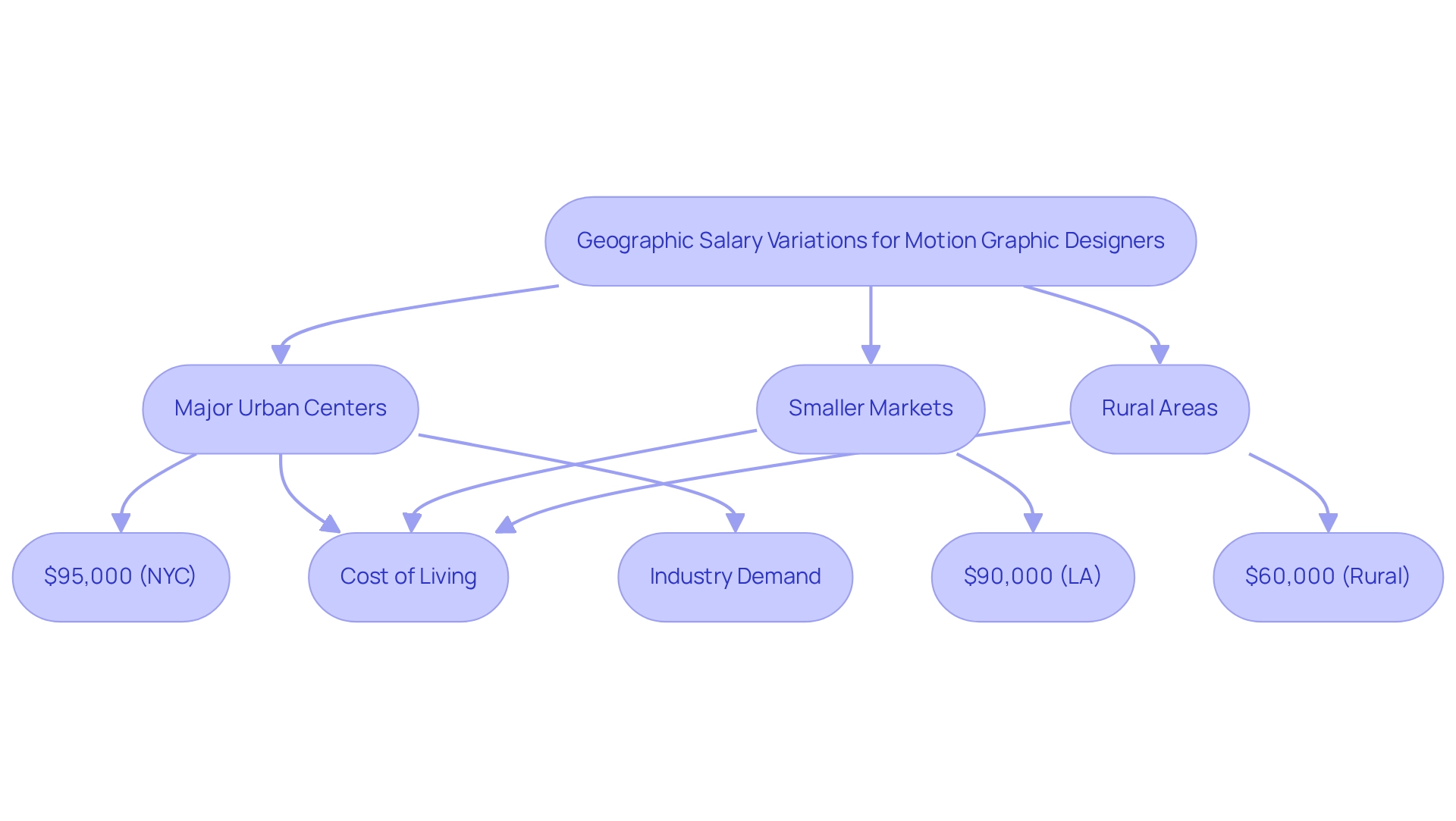
Industry Impact on Motion Graphic Designer Earnings
The salary of a motion graphic designer is significantly influenced by the sector in which they operate. Designers in the advertising field typically command higher compensation, often due to the dynamic atmosphere and the critical nature of client campaigns. For example, senior motion graphic artists in the USA, who generally possess over eight years of experience, can expect to target roles offering a motion graphic designer salary of approximately $110,000 per year. This figure reflects the high demand for skilled professionals capable of delivering impactful visual content under tight deadlines.
Conversely, those employed in corporate settings may face lower compensation ranges; however, they benefit from greater job stability and comprehensive benefits. This trade-off can be appealing for creators seeking a more predictable work-life balance. Moreover, the film and television sector presents competitive salary opportunities, particularly for creators engaged in high-profile projects, where the stakes are elevated and the potential for creative expression is significant.
Salary information underscores the wide range of earnings associated with motion graphic designer salaries within the design sector. For instance, wage percentiles indicate that while the lowest 10% of visual artists earn approximately $17.51 per hour, the top 10% can earn as much as $48.29 per hour. This disparity emphasizes the importance of industry selection in determining a creator’s financial trajectory, particularly in relation to motion graphic designer salary.
Furthermore, the Southern Vermont nonmetropolitan region stands out for having the highest concentration of visual artists, featuring an hourly average wage of $29.98 and a location quotient of 2.20, illustrating regional variations in salary expectations. Understanding these industry dynamics is crucial for visual artists as they advance in their careers, allowing them to align their skills and ambitions with the most lucrative opportunities available in the market. As Maggie Fry, an author, aptly notes, “It’s easy to learn animation design and begin a new career,” highlighting the accessibility of this field for aspiring creators.
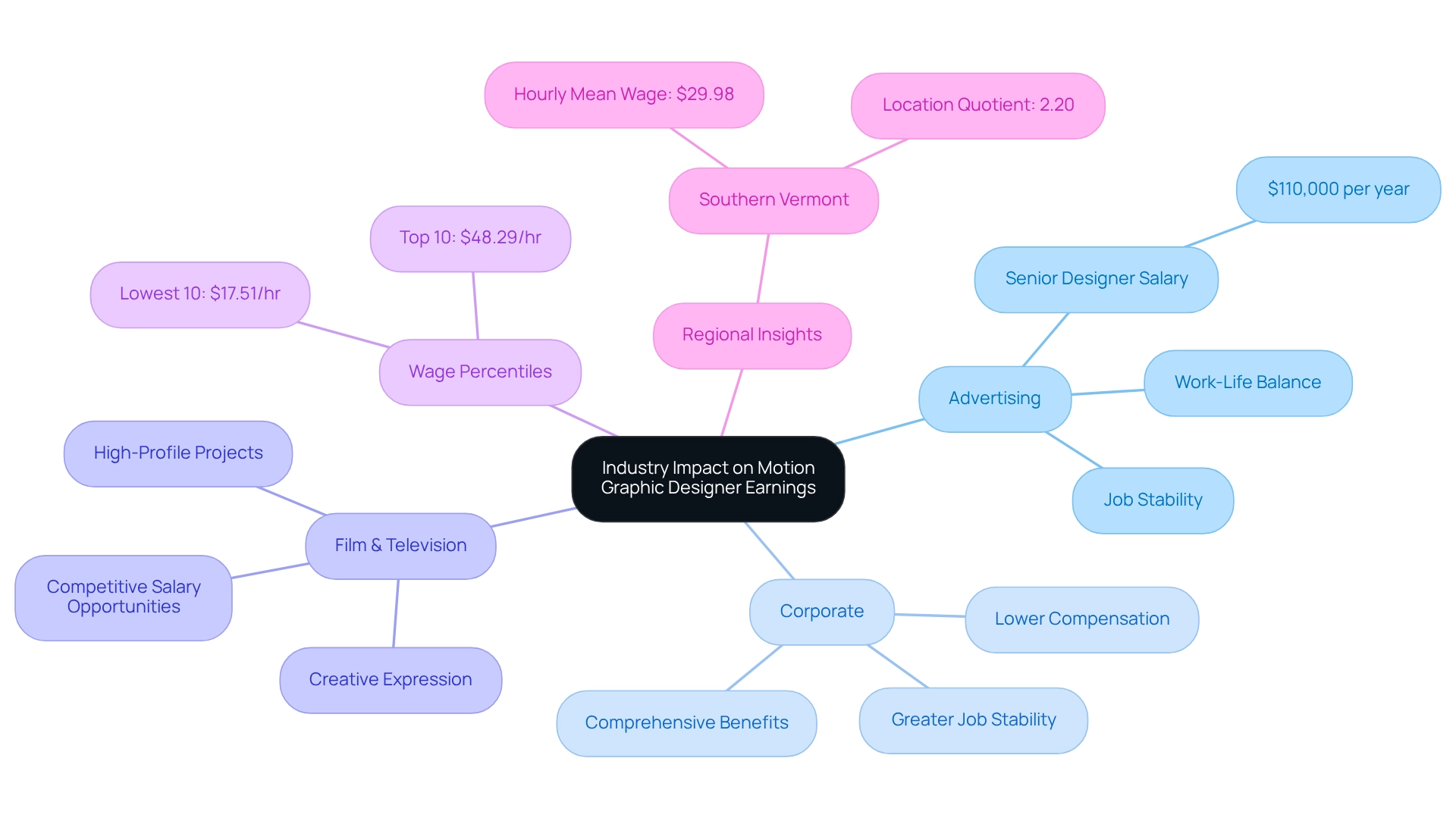
Career Outlook and Future Salary Trends for Motion Graphic Designers
The career outlook for motion graphic designers is exceptionally bright, with the U.S. Bureau of Labor Statistics forecasting a robust 16% growth in employment opportunities through 2030. This surge is largely fueled by the escalating demand for digital content across diverse platforms, including social media, streaming services, and advertising. As the sector continues to progress, the motion graphic designer salary is expected to increase, particularly for individuals who actively enhance their skill sets and adopt new technologies.
Designers focusing on innovative fields such as virtual reality and augmented reality are likely to see even more substantial pay increases as these sectors gain traction.
In May 2023, the median annual wage for all workers was $48,060, serving as a benchmark for discussions about motion graphic designer salary in this field. Industry experts emphasize the importance of adaptability and continuous learning in this dynamic environment. For instance, Reginald Reynolds, a professor at Angelina College, remarks, “There is value in working with vectors and bezier curves in Adobe Illustrator,” underscoring vital skills for animators.
Furthermore, Brockett Horne highlights UI/UX proficiency and animated visuals as prominent qualifications on resumes, emphasizing the changing skill set required in the field.
Essential abilities for visual artists encompass creativity, artistic talent, communication skills, and time-management capabilities. Instructors advocate for cultivating curiosity and refining effective communication skills as vital qualities for success in visual design. As the landscape shifts, those who can self-teach and stay ahead of trends will find themselves in high demand, thereby enhancing their motion graphic designer salary and solidifying their earning potential.
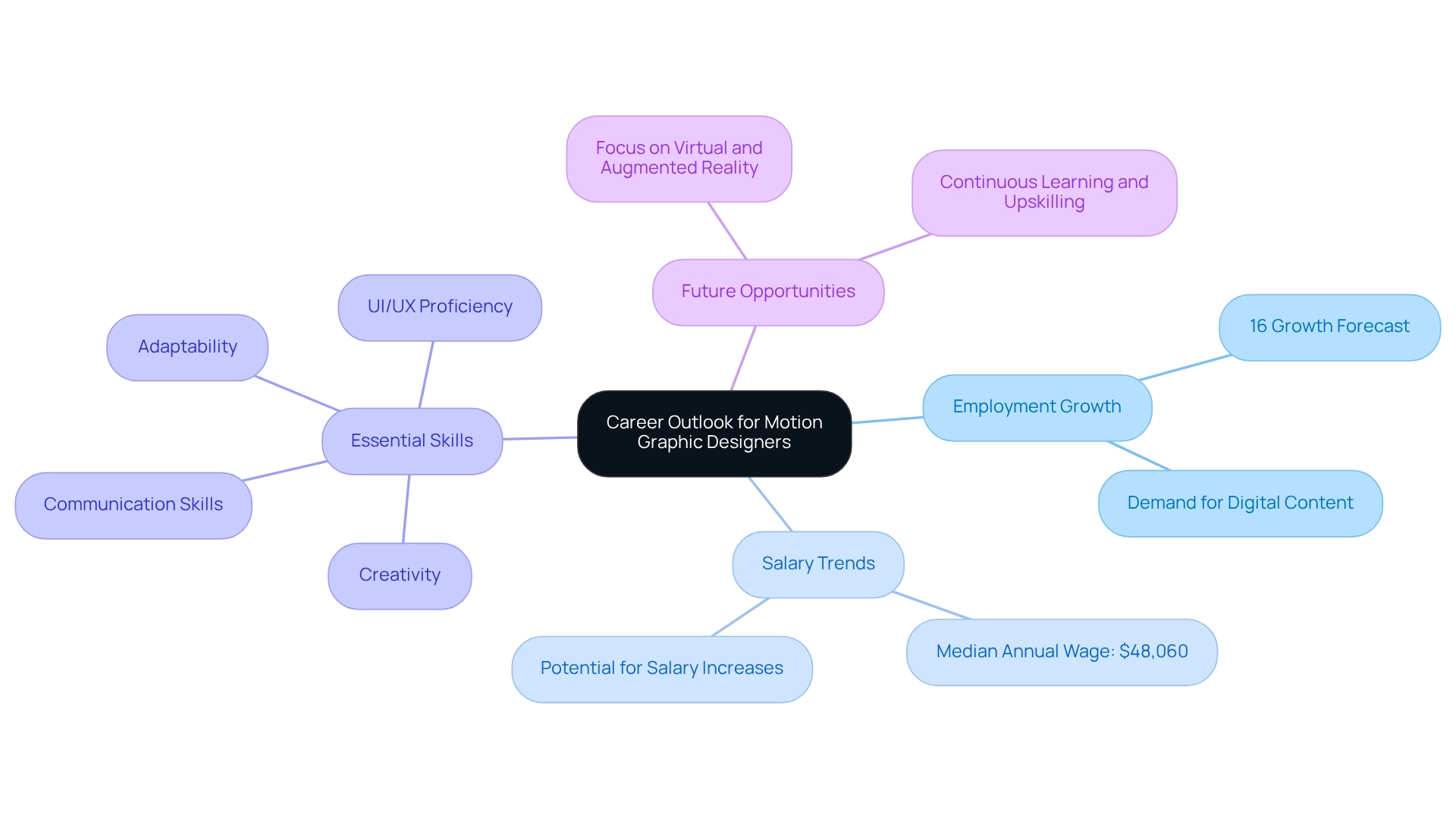
Skills and Qualifications That Boost Motion Graphic Designer Salaries
To maximize motion graphic designer salaries, artists must cultivate a comprehensive skill set that includes proficiency in essential software such as Adobe After Effects, Cinema 4D, and Adobe Premiere Pro. Mastery of these tools is crucial, as they are widely recognized as industry standards. Furthermore, skills in 3D animation, visual effects, and storytelling are increasingly valuable, significantly enhancing an artist’s marketability in a competitive landscape.
Continuous learning is vital; engaging in online courses and workshops allows designers to stay abreast of evolving industry trends and technologies. Connecting within the field and building a strong portfolio that highlights a variety of projects can further enhance career opportunities and earning potential.
Case studies demonstrate the effect of skill proficiency on compensation results. For instance, successful campaigns executed by WonderEight for Miranda and Quaker Oats not only highlight the importance of creative execution but also underscore the necessity of technical skills in achieving measurable results. These campaigns illustrate how individuals who effectively blend creativity with technical skills are often rewarded with a higher motion graphic designer salary and more substantial opportunities.
Additionally, the success stories of Castania and Motorola further emphasize the effectiveness of WonderEight’s approach, showcasing how a strong skill set can lead to impactful brand experiences. Professional guidance highlights that the environment for animated visual artists is consistently changing, and those who adjust by improving their skill sets will discover themselves in a beneficial position. As the industry expands, the need for skilled professionals remains elevated, creating a favorable moment for creators to invest in their growth and seize emerging opportunities.
As one expert noted, “Absolutely not! You can become a Motion Designer at any age,” reinforcing the message that skill development is accessible to everyone.
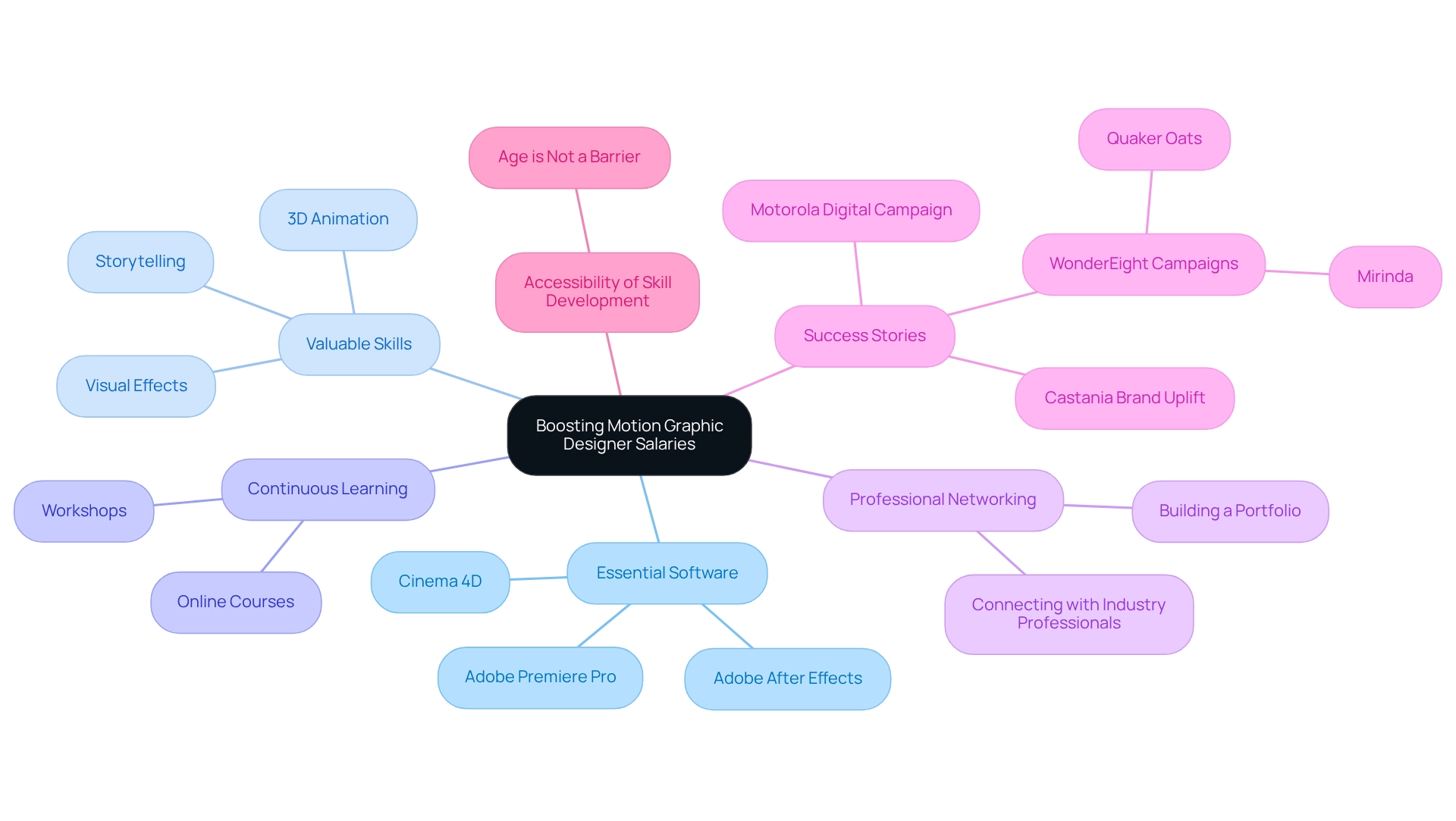
Frequently Asked Questions About Motion Graphic Designer Salaries
Frequent inquiries about the motion graphic designer salary typically encompass several crucial elements. Firstly, what is the initial compensation for entry-level creators? Entry-level positions in this field generally commence at around $50,000 annually, exemplifying a motion graphic designer salary that reflects the foundational skills necessary for the role.
However, it is essential to recognize that the yearly average income for visual artists, including motion graphic designers, hovers around $91,750, as reported by Facilities Support Services. This figure provides a broader perspective on compensation expectations within the industry.
Another common question revolves around the comparison between freelance work and salaried positions. Freelancers may command higher rates per project, potentially leading to increased earnings; however, the income variability they experience can complicate financial planning, much like the fluctuations seen in a motion graphic designer salary. Facilities Support Services reports an hourly average wage of $44.11 for graphic artists, which holds particular relevance for freelancers evaluating their motion graphic designer salary.
When considering ways to enhance earning potential, the most valuable skills come into focus. Proficiency in advanced software, especially tools like Adobe After Effects and Cinema 4D, combined with expertise in 3D animation and strong storytelling abilities, are highly coveted in the industry. As noted by Zippia, ‘The variety of abilities you hold and any specialized skills you possess could influence the job you secure and, consequently, impact your motion graphic designer salary.’
These competencies not only enrich a designer’s portfolio but also significantly influence discussions surrounding the motion graphic designer salary.
Lastly, the motion graphic designer salary can vary markedly based on geographical location. In major metropolitan areas, the motion graphic designer salary is often significantly higher than that of their counterparts in smaller markets, driven by greater demand for creative talent and the increased cost of living. For example, in cities like San Francisco and New York, the motion graphic designer salary frequently surpasses the national average, reflecting the competitive landscape of the industry.
Furthermore, insights from case studies on essential skills for video game designers underscore that skills such as motion graphics and software proficiency are also applicable to motion graphic designers, further highlighting the importance of skill diversity in this field.
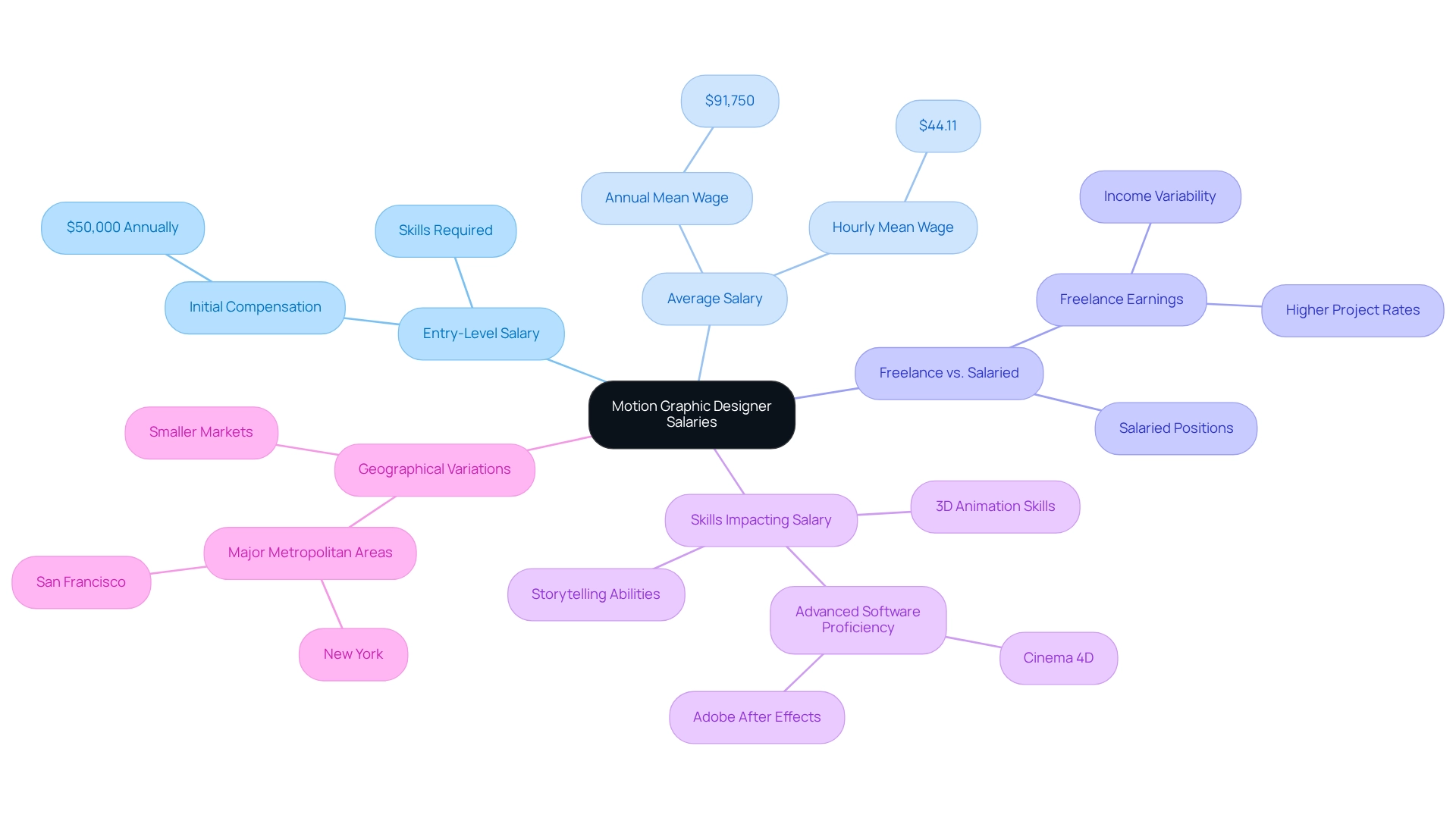
Conclusion
Motion graphics design resides at the dynamic intersection of creativity and technology, profoundly influencing a myriad of media platforms and industries. As visual storytelling becomes an indispensable element in marketing and branding, the demand for proficient motion graphic designers is on the rise. By grasping the factors that affect salaries—such as experience, geographic location, and industry sector—aspiring designers can equip themselves with essential knowledge to maximize their earning potential.
With projections indicating an increase in the average salary for motion graphic designers and the expansion of opportunities in digital content creation, professionals in this field are strategically positioned for a prosperous future. Mastery of advanced software tools and the growing significance of skills like 3D animation and storytelling will be crucial in navigating this ever-evolving landscape. As the industry embraces innovation and adapts to emerging technologies, those who commit to continuous learning and skill enhancement will undoubtedly thrive.
Ultimately, the vibrant nature of motion graphics design not only presents a plethora of creative opportunities but also highlights the pivotal role these designers play in crafting engaging narratives. By remaining attuned to industry trends and refining essential skills, aspiring motion graphic designers can forge successful careers while contributing to the rich tapestry of visual storytelling that captivates audiences globally.
Frequently Asked Questions
What is motion graphics design?
Motion graphics design is a dynamic field that combines design principles with animation techniques to create engaging visual content for various media platforms, including film, television, advertising, and digital environments.
What software tools are commonly used in motion graphics design?
Designers often use advanced software tools such as Adobe After Effects and Cinema 4D, which are ideal for 3D modeling, animation, and rendering.
Why are animated visuals significant in media?
Animated visuals are crucial because they engage viewers, leading to a growing demand for skilled animation designers. The animation sector has seen considerable growth, particularly in advertising, where brands utilize animation to create memorable campaigns.
What recent trends are emerging in motion graphics design?
Recent trends include the integration of augmented reality (AR) and the blending of 2D and 3D animation techniques, allowing for innovative projects that enhance brand storytelling and create immersive experiences.
What are the fundamental skills necessary for success in motion graphics design?
Mastering the fundamentals of design and animation is essential, including principles such as simplicity, consistency, timing, visual hierarchy, storytelling, and iterative feedback.
How does experience affect the salary of a motion graphic designer?
Experience significantly influences salary, with entry-level designers earning less than those with extensive experience, who can command higher salaries. The 90th percentile yearly salary for visual artists, including motion graphic designers, can reach $100,450.
What geographic factors influence motion graphic designer salaries?
Geographic location plays a crucial role, with designers in major metropolitan areas typically earning higher salaries due to increased demand and a higher cost of living.
How does the industry sector impact the salary of motion graphic designers?
Designers working in advertising or film often earn more than those in corporate settings, where budgets for creative talent may be more limited.
How can a designer’s portfolio affect their salary?
A strong portfolio showcasing a variety of complex projects can attract higher-paying opportunities, as demonstrated by successful visual artists who have enhanced their reputation through impactful work.
What future trends might affect motion graphic designer salaries by 2025?
The increasing demand for digital content and the rise of automated design tools will shape the salary landscape, with a strong demand for skilled professionals remaining despite potential reductions in freelance opportunities.



